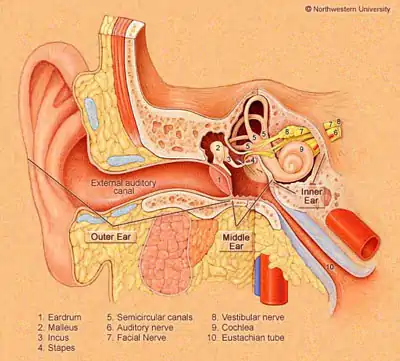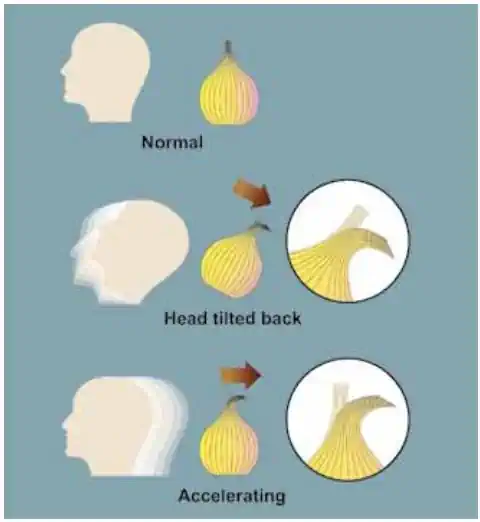Vestibular System
The ear and its functions are a crucial part of the pilot's situational awareness and, therefore, decision-making process.
Introduction to the Vestibular System
- The ear and its functions are a crucial part of the pilot's situational awareness and, therefore, decision-making process.
- The two parts of concern are the semicircular canals and the otolith organs.
- The semicircular canals detect angular acceleration of the body.
- The otolith organs detect linear acceleration and gravity.
- Pilots experiencing an ear block are vulnerable to mixed signals from the inner ear.
- When you've got a solid understanding of the vestibular system? Don't miss the vestibular system quiz below, and the topic summary.
Semicircular Canals
- The ear consists of the inner, middle, and outer ear. [Figure 1]
- The three canals in the inner ear, arranged at approximately right angles to each other, detect the roll, pitch, and yaw axes.
- In each canal is a fluid called denolymph fluid.
- In the center of the canal is the cupola, a gelatinous structure that rests upon sensory hairs located at the end of the vestibular nerves.
- It is the movement of these hairs within the fluid that causes sensations of motion. [Figure 2]
- Due to the friction between the fluid and the canal, it may take approximately 15-20 seconds for the fluid in the ear canal to reach the same speed as the canal's motion.
- A mismatch between what the fluid/hairs are telling your body and what is happening can lead to disorientation.
- To illustrate what happens during a turn, visualize the aircraft in straight and level flight.
- With no acceleration of the aircraft, the hair cells are upright, and the body senses that no turn has occurred.
- Placing the aircraft into a turn puts the semicircular canal and its fluid into motion, with the fluid within the semicircular canal lagging behind the accelerated canal walls. [Figure 3]
- This lag creates a relative movement of the fluid within the canal.
- The canal wall and the cupula move in the opposite direction from the motion of the fluid.
- The brain interprets the movement of the hairs to be a turn in the same direction as the canal wall.
- The body correctly senses the turn.
- If the turn continues at a constant rate for several seconds or longer, the motion of the fluid in the canals catches up with the walls of the canals.
- The hairs are no longer bent, and the brain receives the false impression that turning has stopped.
- Thus, the position of the hair cells and the resulting sensation during a prolonged, constant turn in either direction will result in the false sensation of no turn, which can result in illusions such as the graveyard spiral.
- When the aircraft returns to straight-and-level flight, the fluid in the canal moves briefly in the opposite direction.
- The brain receives a false signal, interpreted as movement in the opposite direction.
- In an attempt to correct the perceived turn, the pilot may reenter the turn, placing the aircraft in an out-of-control situation; a condition known as the Coriolis illusion.
Otolith Organs
- The otolith organs similarly detect linear acceleration and gravity.
- Instead of being filled with a fluid, a gelatinous membrane containing chalk-like crystals covers the sensory hairs.
- When the pilot tilts their head, the weight of these crystals causes this membrane to shift due to gravity, and the sensory hairs detect this shift.
- The brain orients this new position to what it perceives as vertical.
- Acceleration and deceleration also cause the membrane to shift similarly.
- Forward acceleration gives the illusion of the head tilting backward.
- As a result, during takeoff and while accelerating, the pilot may experience a steeper-than-normal climb, leading to a tendency to nose down, also known as the somatogravic illusion.
Ear Block
-
Ear Block Causes:
- As the aircraft cabin pressure decreases during ascent, the expanding air in the middle ear pushes the Eustachian tube open, allowing it to equalize in pressure with the cabin pressure by escaping down into the nasal passages.
- As the aircraft cabin pressure decreases during ascent, the expanding air in the middle ear pushes the Eustachian tube open, allowing it to equalize in pressure with the cabin pressure by escaping down into the nasal passages.
- Either an upper respiratory infection, such as a cold or sore throat, or a nasal allergic condition can produce enough congestion around the Eustachian tube to make equalization difficult.
- Consequently, the difference in pressure between the middle ear and the aircraft cabin can build up to a level that prevents the Eustachian tube from opening, making equalization difficult, if not impossible.
- This phenomenon is called an "ear block."
-
Ear Block Effects:
- An ear block produces severe ear pain and loss of hearing that can last from several hours to several days.
- This ear pain may significantly impact a pilot's ability to communicate.
- Rupture of the eardrum can occur in flight or after landing.
- Fluid can accumulate in the middle ear and become infected.
- An ear block produces severe ear pain and loss of hearing that can last from several hours to several days.
-
Ear Block Prevention & Recovery:
- An ear block is prevented by not flying with an upper respiratory infection or a nasal allergic condition.
- Adequate protection is usually not provided by decongestant sprays or drops to reduce congestion around the eustachian tubes.
- Oral decongestants have side effects that can significantly impair pilot performance.
- During climbs and descents, a pilot must periodically open the Eustachian tube by swallowing, yawning, or tensing muscles in the throat, or by using the Valsalva maneuver.
- Descents can be more challenging to relieve since the partial vacuum tends to constrict the walls of the Eustachian tube.
- An ear block is prevented by not flying with an upper respiratory infection or a nasal allergic condition.
Sinus Block
- Moist mucous membranes line the cavities in the bone of the skull.
- The sinuses most frequently affected by pressure changes are the frontal sinuses.
- Frontal sinuses: located above and behind each eye.
- Maxillary sinuses: located in the bones of the cheeks behind the eyes.
-
Blockages:
- Air pressure in the sinuses equalizes through small openings in the nasal passages during altitude changes.
- Either an upper respiratory infection, such as a cold or sinusitis, or a nasal allergic condition can produce enough congestion around the opening to slow equalization.
- As the difference in pressure between the sinus and the cabin increases, it eventually blocks the opening.
- This "sinus block" occurs most frequently during descent.
- The Valsalva maneuver will usually alleviate the problem.
- Infections or allergies can produce enough congestion to slow equalization.
- It can happen in the frontal sinuses, located above each eyebrow, or in the maxillary sinuses, located in each upper cheek.
- Produces excruciating pain in the sinus area.
- A maxillary sinus block can make the upper teeth ache.
- Bloody mucus may discharge from the nasal passages.
- Decongestants can cause pilot impairment.
- It occurs most often in the descent when the pressure difference across the duct increases without relief.
-
Sinus Block Prevention:
- A sinus block is prevented by not flying with an upper respiratory infection or a nasal allergic condition.
- Adequate protection is typically not provided by decongestant sprays or drops to reduce congestion around the sinuses.
- Oral decongestants have side effects that can impair pilot performance.
Private Pilot (Airplane) Human Factors Airman Certification Standards
- Objective: To determine whether the applicant exhibits satisfactory knowledge, risk management, and skills associated with personal health, flight physiology, and aeromedical and human factors related to the safety of flight.
- References: AIM; FAA-H-8083-2 (Risk Management Handbook), FAA-H-8083-3 (Airplane Flying Handbook), FAA-H-8083-25 (Pilot Handbook of Aeronautical Knowledge).
- Private Pilot (Airplane) Human Factors Lesson Plan.
Private Pilot (Airplane) Human Factors Knowledge:
The applicant demonstrates an understanding of:-
PA.I.H.K1:
Symptoms, recognition, causes, effects, and corrective actions associated with aeromedical and physiological issues, including:-
PA.I.H.K1a:
Hypoxia. -
PA.I.H.K1b:
Hyperventilation. -
PA.I.H.K1c:
Middle ear and sinus problems. -
PA.I.H.K1d:
Spatial Disorientation. -
PA.I.H.K1e:
Motion sickness. -
PA.I.H.K1f:
Carbon Monoxide Poisoning. -
PA.I.H.K1g:
Stress. -
PA.I.H.K1h:
Fatigue. -
PA.I.H.K1i:
Dehydration and nutrition. -
PA.I.H.K1j:
Hypothermia. -
PA.I.H.K1k:
Optical Illusions. -
PA.I.H.K1l:
Dissolved nitrogen in the bloodstream after scuba dives.
-
-
PA.I.H.K2:
Regulations regarding the use of alcohol and drugs. -
PA.I.H.K3:
Effects of alcohol, drugs, and over-the-counter medications. -
PA.I.H.K4:
Aeronautical Decision-Making (ADM) to include using Crew Resource Management (CRM) or Single-Pilot Resource Management (SRM), as appropriate.
Private Pilot (Airplane) Human Factors Risk Management:
The applicant demonstrates the ability to identify, assess, and mitigate risks encompassing:-
PA.I.H.R1:
Aeromedical and physiological issues. -
PA.I.H.R2:
Hazardous attitudes. -
PA.I.H.R3:
Distractions, task prioritization, loss of situational awareness, or disorientation. -
PA.I.H.R4:
Confirmation and expectation bias.
Private Pilot (Airplane) Human Factors Skills:
The applicant exhibits the skills to:-
PA.I.H.S1:
Associate the symptoms and effects for at least three of the conditions listed in K1a through K1l above with the cause(s) and corrective action(s). -
PA.I.H.S2:
Perform self-assessment, including fitness for flight and personal minimums, for actual flight or a scenario given by the evaluator.
Vestibular System Knowledge Quiz
Vestibular System Conclusion
- The feelings caused by changing altitudes (or pressures) differ from person to person, and often regular fliers will become accustomed to them.
- More significant than the actual change in pressure is the rate at which it changes, resulting in ears popping when climbing/descending at a rate of about 750-1000 feet per minute.
- Consult a physician if any problems occur. As always, remember the IMSAFE checklist for medications to ensure you're fit to fly.
- Pilots experiencing an ear block are vulnerable to mixed signals from the inner ear, which can lead to both loss of situational awareness and illusions in flight.
- If a sinus block does not clear shortly after landing, consult a physician.
- Still looking for something? Continue searching:
Vestibular System References
- Federal Aviation Administration - Pilot/Controller Glossary.
- Aeronautical Information Manual (8-1-2b) Effects of Altitude.
- Aeronautical Information Manual (8-1-2c) Effects of Altitude.
- AmericanHearing.org.
- AOPA - I Nose This Much is True: Drugs, Blockages, and Bleeds.
- Instrument Flying Handbook (1-4) Ear.
- Pilot Handbook of Aeronautical Knowledge.


